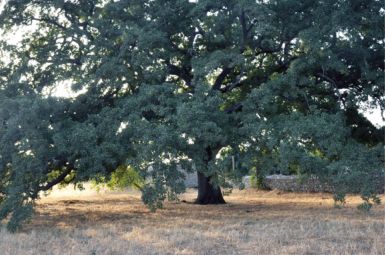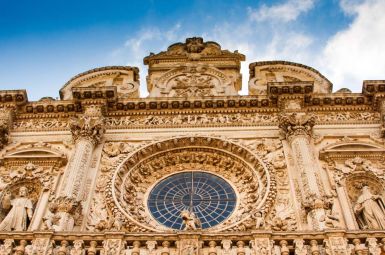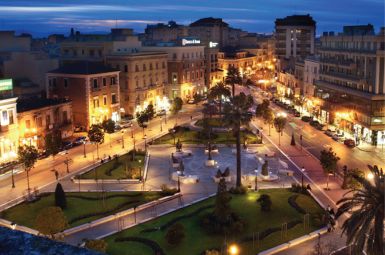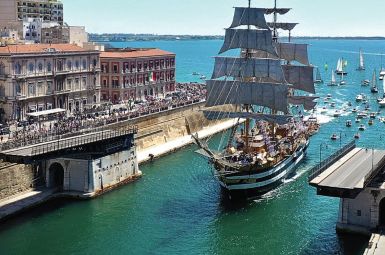
Brisighella
Il Borgo di Brisighella
Il Trittico dei Sogni: I Tre Colli
Il borgo vive all’ombra di tre pinnacoli di roccia gessosa, baluardi storici e spirituali che ne definiscono l’orizzonte:- La Rocca Manfrediana: Maestosa fortezza trecentesca, poi arricchita dalla dominazione veneziana. Oggi è un superbo esempio di arte militare medievale, con il suo Torrione che offre una vista che domina l’intero Appennino.
- La Torre dell’Orologio: Un antico baluardo difensivo, ricostruito nel XIX secolo e caratterizzato dal suo singolare quadrante a sei ore. Simbolo di un tempo scandito dal lento respiro della storia.
- Il Santuario del Monticino: Luogo di profonda venerazione, eretto nel Settecento, che veglia sul paese, completando un panorama di rara potenza evocativa.
La Via degli Asini: Un Percorso d’Aria
Il vero emblema dell’ingegno e della storia brisighellese è la Via degli Asini. Questa strada coperta e sopraelevata, una sorta di tunnel aereo, fu concepita nel XII secolo per proteggere il transito dei birocciai e dei loro somari che trasportavano il gesso dalle cave. Oggi, camminare sotto le arcate di questa via è un viaggio ipnotico, una prospettiva unica che cattura l’anima autentica del borgo, con le sue finestre a mezzaluna che si affacciano sulle viuzze sottostanti.L’Oro Verde della Romagna
Brisighella è terra di prelibatezze ineguagliabili. L’eccellenza culinaria culmina nell’Olio Extra Vergine di Oliva Brisighello DOP, il primo in Italia ad ottenere il prestigioso marchio, derivato dalla pregiata cultivar autoctona ‘Nostrana di Brisighella’. Un olio celebrato per le sue note eleganti, simbolo di una tradizione olivicola che affonda le radici nell’epoca romana. A completare il paniere di sapori, troviamo il raro Carciofo Moretto e la tradizionale Pera Volpina. Brisighella non è soltanto un borgo da visitare, è un tesoro da scoprire, un luogo dove ogni pietra racconta una leggenda e ogni sapore è un’ode all’autenticità romagnola.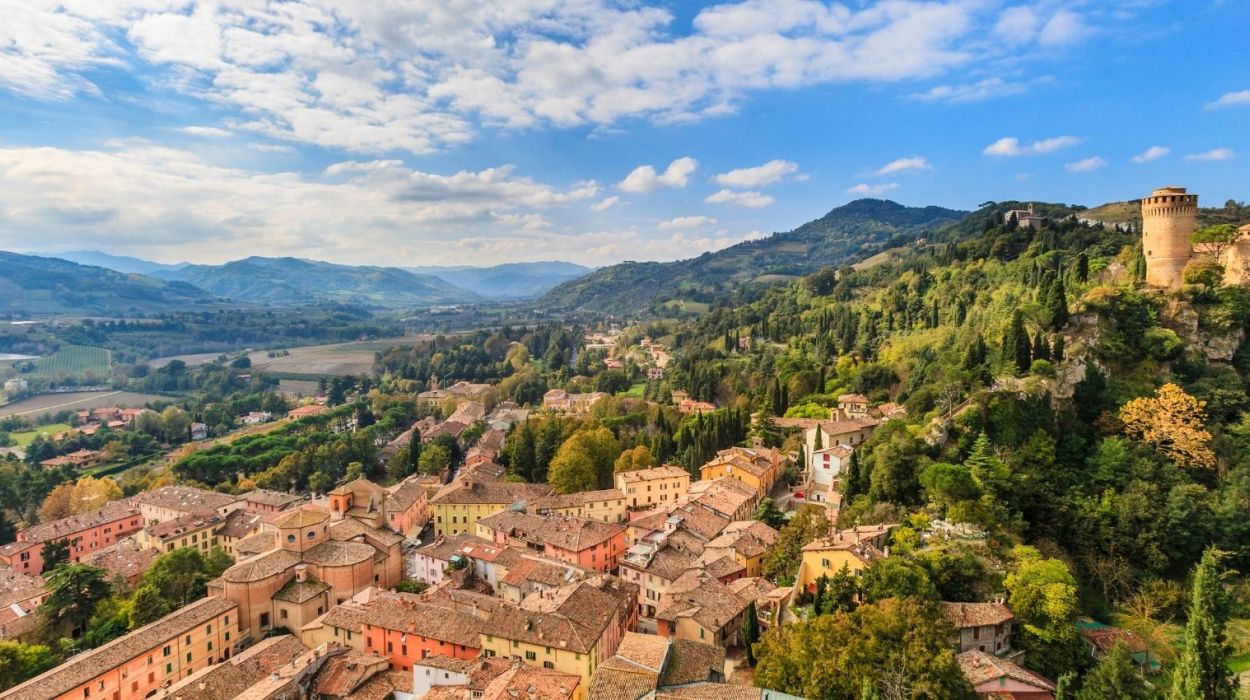
Il Borgo d’Italia
tutto da scoprire ed esplorare
Monumenti
BRISIGHELLA: IL SENTIERO DEGLI DEI E DEGLI EROI
Brisighella non è solo un borgo, è un’esperienza verticale. Arroccata sui fianchi della Vena del Gesso Romagnola, questa perla medievale in provincia di Ravenna è definita dai suoi iconici monumenti, che si innalzano da tre spuntoni rocciosi, plasmati dalla storia e dalla forza della natura. Un itinerario tra fortezze, misteri architettonici e panorami che tolgono il fiato.
La Triade Ispiratrice: I Tre Colli
Il profilo inconfondibile di Brisighella è un trittico di simboli, un invito a salire e contemplare secoli di storia racchiusi nel paesaggio.
1. La Rocca Manfrediana: Fortezza e Museo
Regina incontrastata, la Rocca Manfrediana (o Veneziana) si erge come un custode eterno. Datata al XIII secolo, fu voluta dai Manfredi di Faenza e successivamente rafforzata dalla Repubblica di Venezia. Le sue imponenti torri cilindriche, il Torrione Veneziano e il Torricino trecentesco, testimoniano un’arte militare medievale d’eccellenza.
- L’Attrattiva: Varca il ponte levatoio e percorri i camminamenti di ronda. All’interno, scopri il Museo dell’Uomo e del Gesso, un’immersione nel legame millenario tra l’uomo e la roccia che modella l’intera valle. Un panorama a 360 gradi premia la salita, unendo il verde delle colline al luccichio del gesso.
2. La Torre dell’Orologio: Il Tempo Sospeso
Su un colle adiacente, si erge la Torre dell’Orologio, baluardo difensivo eretto originariamente nel 1290. La struttura attuale, ricostruita nel 1850, cela una singolare curiosità: il suo meccanismo conta solo sei ore.
- L’Attrattiva: La salita è un premio per lo sguardo. Dalla sua sommità, non solo si domina il borgo e i suoi tetti in cotto, ma si abbraccia con gli occhi l’intera vallata, incorniciata dai suggestivi calanchi di argilla azzurra. L’ingresso è libero, offrendo un punto panoramico impareggiabile per gli amanti della fotografia e della quiete.
3. Il Santuario del Monticino: Fede e Geologia
Il terzo colle ospita il Santuario della Madonna del Monticino, un luogo di profonda spiritualità sorto nel 1758. Custodisce un’antica immagine mariana in terracotta policroma, venerata da secoli.
- L’Attrattiva: Nascosto proprio dietro il santuario, si trova un eccezionale Museo Geologico all’aperto, allestito nell’area di una ex cava di gesso. Questo sito offre una prospettiva affascinante sulla natura carsica della Vena del Gesso Romagnola, rendendo l’esperienza un connubio unico tra architettura sacra e archeologia naturale.
La Meraviglia Nascosta: Via degli Asini
Nel cuore del centro storico, si cela l’elemento più distintivo e affascinante di Brisighella: la Via del Borgo, nota universalmente come Via degli Asini. Questa strada sopraelevata e completamente coperta, risalente al XII secolo, corre lungo il perimetro delle case.
- L’Attrattiva: Percorri questo singolare tunnel aereo che fungeva da camminamento di ronda e da ricovero per i birocciai e i loro animali. Ammira le caratteristiche finestre a semicerchio che si aprono sul borgo sottostante. È un’architettura unica al mondo, un “sentiero d’aria” che invita a un viaggio indietro nel tempo, nel cuore più intimo della vita medievale.
Brisighella non è soltanto storia, è un’emozione da percorrere a piedi, un tesoro medievale scavato nel gesso e proiettato verso il cielo. Vieni a scoprire i suoi monumenti: sono la chiave per accedere a un tempo e un luogo in cui la bellezza è stata scolpita per durare.
Curiosità
BRISIGHELLA: I SEGRETI DI UN BORGO CHE SFIDA IL TEMPO
Brisighella non è solo una cartolina medievale; è un concentrato di storie bizzarre, eccellenze uniche e architetture che non troverete in nessun altro luogo. Immergetevi nelle curiosità che rendono questo borgo, Bandiera Arancione e gioiello dell’Emilia-Romagna, una destinazione assolutamente irrinunciabile.
L’Orologio che Misura il Giorno in Sei Ore
Quando salite alla Torre dell’Orologio (uno dei celebri “Tre Colli”), noterete un dettaglio sorprendente che vi riporterà indietro di secoli: il suo quadrante ha solo sei ore. Non è un errore, ma la testimonianza dell’antico “Sistema Ora Italica”.
- In questo sistema, introdotto a partire dal XIV secolo, le ore venivano contate a partire dal tramonto. L’orologio segnava la fine del giorno, e per ragioni di semplicità meccanica e di lettura, si ricorreva al quadrante di sei ore ripetuto quattro volte. Un autentico salto nel tempo che ignora le convenzioni moderne.
La Strada Coperta Più Unica al Mondo: La Via degli Asini
Il cuore pulsante del centro storico, la Via del Borgo, è nota a tutti come Via degli Asini. La sua natura è unica: è una strada sopraelevata, completamente coperta e costruita lungo il fronte roccioso delle case.
- Il Motivo: Il nome e la sua architettura inusuale derivano dalla sua funzione originale. La via non era solo un camminamento di ronda difensivo, ma serviva soprattutto come rifugio coperto per gli asini dei “birocciai” (carrettieri). Questi animali erano essenziali per il trasporto del prezioso gesso estratto dalle cave circostanti (la Vena del Gesso). Le particolari finestre a mezzaluna che si aprono sulla piazza erano l’unica fonte di luce, trasformando l’ambiente in un magazzino-passaggio che testimonia l’antica e faticosa vita mineraria del borgo.
L’Olio che Nasce da un Antico Frantoio Romano
Brisighella è terra di prelibatezze, ma il suo Olio Extra Vergine di Oliva Brisighella DOP è una vera leggenda. È stato il primo olio in Italia a ottenere la Denominazione di Origine Protetta (DOP) nel 1996.
- Radici Romane: La storia dell’olio di Brisighella non è medievale, ma romana. Presso la vicina Pieve di San Giovanni in Ottavo (detta Pieve del Tho), nel IX secolo, fu scoperto un piccolo frantoio risalente all’epoca romana, a riprova di una tradizione olivicola ininterrotta di oltre duemila anni.
- Monocultivar d’Eccellenza: L’olio Brisighella DOP, commercializzato con marchi come “Brisighello”, è ottenuto per almeno il 90% dalla cultivar autoctona “Nostrana di Brisighella”. Questa singolare concentrazione varietale conferisce al prodotto un sapore fruttato intenso, pulito, con note di amaro e piccante perfettamente equilibrate.
Queste curiosità non solo impreziosiscono l’esperienza di Brisighella, ma svelano il profondo legame tra l’ingegno umano, la storia del gesso e la generosità di una terra che produce eccellenze millenarie.
Personaggi
BRISIGHELLA: LA TERRA CHE HA GENERATO CARDINALI E MAESTRI DELL’ARTE
Brisighella, con il suo profilo scolpito dai “Tre Colli”, non ha solo plasmato paesaggi di straordinaria bellezza, ma ha dato i natali a figure che hanno lasciato un segno indelebile nella storia, nell’arte e nelle gerarchie ecclesiastiche. Il borgo romagnolo è una fucina di talenti che eccellono in ambiti diversi, dalla Curia romana ai palcoscenici dell’arte moderna.
Il Primato Ineguagliabile: La Città dei Cardinali
Uno dei dati statistici più sorprendenti e difficilmente superabili di Brisighella riguarda il suo legame con il Vaticano. Il piccolo borgo vanta il primato di aver dato i natali a ben otto Cardinali nella sua storia, figure che hanno ricoperto cariche di altissimo prestigio in seno alla Chiesa Cattolica.
Tra i più noti e influenti si ricordano:
- Amleto Giovanni Cicognani (1883 – 1973): Cardinale Segretario di Stato e figura chiave nella Curia romana.
- Achille Silvestrini (1923 – 2019): diplomatico di spicco e Prefetto della Congregazione per le Chiese Orientali.
- Dino Monduzzi (1922 – 2006): altro porporato di alto rango, testimonianza di una tradizione cattolica forte e radicata che ha proiettato i suoi figli fino ai vertici del potere religioso globale.
L’Eredità Artistica: Pittori e Litografi del ‘900
Brisighella non è solo fede, ma anche fermento artistico, con figure che hanno saputo interpretare e celebrare la Romagna del Novecento:
Giuseppe Ugonia (1881 – 1944): Il Poeta della Litografia
Originario di Brisighella, Giuseppe Ugonia è uno dei nomi più importanti nel panorama dell’arte grafica italiana a cavallo tra il XIX e il XX secolo. Specializzato in pittura e, soprattutto, in litografia, le sue opere furono esposte nelle più prestigiose sedi internazionali.
- L’Omaggio del Borgo: Il legame con la sua città natale è perpetuato dal Museo Civico Giuseppe Ugonia, dove sono conservate numerose sue opere, permettendo ai visitatori di scoprire la sua eccezionale maestria tecnica e la sua profonda sensibilità.
Domenico Rambelli (1886 – 1972): Lo Scultore dei Monumenti
Sebbene non nativo di Brisighella (era di Faenza), la sua opera più iconica legata alla memoria storica del territorio si trova proprio qui. Domenico Rambelli, considerato uno dei massimi scultori del Novecento italiano, è l’autore del:
- “Fante che dorme”: Questo suggestivo Monumento ai Caduti nel Parco delle Rimembranze di Brisighella è una delle opere più significative dell’artista. La figura in bronzo del soldato, in un sonno eterno, incarna un potente simbolo di pace e memoria.
La città di Brisighella, quindi, è un crocevia di eccellenze, un luogo dove la spiritualità più alta e l’espressione artistica più profonda hanno trovato terreno fertile per fiorire e influenzare il mondo intero.
Ricette Tipiche
IL SAPORE AUTENTICO DI BRISIGHELLA: UN VIAGGIO CULINARIO TRA OLIO DOP E TESORI DELLA TERRA
La cucina di Brisighella è l’espressione diretta del suo territorio collinare, un luogo dove la semplicità contadina si sposa con prodotti di eccellenza unici al mondo. Le ricette tipiche non sono solo piatti, ma veri e propri racconti della Romagna più genuina.
La Regina della Sfoglia: La “Spoja Lorda”
Tra i primi piatti, la “Spoja Lorda” si distingue per il suo nome singolare e la sua storia di economia domestica. Tradotta letteralmente come “sfoglia sporca”, questa pasta all’uovo è il simbolo della maestria e dell’ingegno delle azdore romagnole.
- Il Concetto: Nasce dall’esigenza di utilizzare i rimasugli di sfoglia e ripieno (di solito a base di squacquerone o raviggiolo e parmigiano) avanzati dalla preparazione dei più elaborati cappelletti. La sfoglia, anziché essere riempita e chiusa accuratamente, viene solo “lordata” – cioè, spalmata – con un velo di ripieno, e poi tagliata in piccoli quadrati non separati completamente.
- La Degustazione: Questi piccoli ravioli imperfetti vengono tradizionalmente cotti e serviti in un saporito brodo di cappone, risultando in un piatto confortante, veloce e squisitamente romagnolo. Un capolavoro nato dal riutilizzo, che oggi è un’icona gastronomica di Brisighella.
L’Oro Verde e Spinato: Carciofo Moretto e Olio Brisighella DOP
La gastronomia brisighellese ruota attorno a due prodotti autoctoni di altissima qualità, entrambi figli del microclima esclusivo della Vena del Gesso Romagnola:
Il Carciofo Moretto
Unico nel suo genere, il Carciofo Moretto di Brisighella è una varietà spinosa e selvatica che cresce solo sui versanti più assolati dei calanchi gessosi. Non ha subito interventi di miglioramento genetico dal XV secolo, mantenendo un gusto e un aroma inimitabili.
- Uso Tipico: Per assaporare la sua essenza, viene spesso consumato crudo o appena sbollentato.
- L’Abbinamento Perfetto: L’unico condimento ammesso è l’Olio Extra Vergine di Oliva Brisighella DOP, che, grazie a una base aromatica comune data dallo stesso terroir, ne esalta il sapore pulito e la nota leggermente amara.
L’Olio Extra Vergine di Oliva Brisighella DOP
Primo olio in Italia ad ottenere la certificazione DOP, l’olio di Brisighella è un monovarietale ottenuto dalla pregiata cultivar “Nostrana di Brisighella”.
- Caratteristiche: Di un inconfondibile colore verde smeraldo, il suo sapore è fruttato, piccante e leggermente amarognolo.
- In Cucina: Essendo un prodotto di eccellenza, è ideale per condimenti a crudo, esaltando la struttura di carni bianche alla griglia o di piatti di pesce ricchi. È la firma aromatica indispensabile in ogni ricetta che voglia dirsi autenticamente brisighellese.
Le Delizie Dolci: La Pera Volpina
Per concludere, la tradizione dolciaria locale celebra un frutto antico: la Pera Volpina. Una piccola pera selvatica, particolarmente dura e aspra se mangiata cruda.
- Tradizione Contadina: Non è adatta al consumo fresco, ma diventa protagonista se cotta. Viene tipicamente preparata al forno o in umido con vino rosso (spesso Sangiovese) e zucchero, sprigionando un sapore dolce e speziato che rappresenta la chiusura perfetta di un pasto romagnolo.
